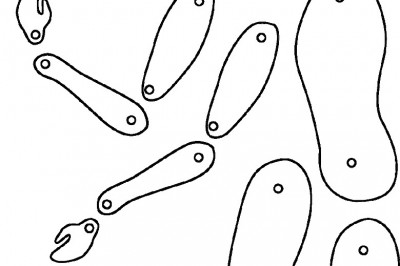Ergonomic: What is it? What is the Objective of Ergonomics Programs?
According to the Polish Ergonomics Society, the term "Ergonomics" was originally coined by Wojiech Jastrzebowski, a polish educator and scientist almost one hundred and fifty years ago. The term "Ergonomics" comes from the Greek root words, "ergos", meaning, "work", and "nomos", meaning "laws", -the laws of work. Today, the term "ergonomics" is becoming more and more common, there are "ergonomic chairs", "ergonomic pens" and "ergonomic toothbrushes"; basically everything these days is "Ergonomically designed". In more practical terms, the concept of ergonomics has come to mean finding ways to "work smarter-not harder" and "Fit the work to the worker." In other words, "ergonomics" is the study of the physical and cognitive demands of work to ensure a safe and productive workplace.
Ergonomics is designing and improving the workplace, workstation, tools, equipment, and procedures of work in order to limit fatigue discomfort and injuries, while efficiently achieving personal and organizational goals. Ergonomics is improving the design of jobs and workstations that have unsafe qualities or have caused injury. Ergonomics is also defined as controlling errors, wasted motions, tools, material damage and quality. NIOSH (National Institute of Occupational Safety and Health) defines Ergonomics as "the discipline that strives to develop and assemble information on peoples capacities and capabilities for use in designing jobs, products, workplaces and equipment."
Health Ergonomics is based on the science of human physiology, pathology and its relationship to work. The healthcare professional already has the knowledge base and training in human physiology and the mechanisms of injury, required to decrease the incidence and severity of injuries in the workplace. This knowledge and experience base can also be used to optimize work capacity of both healthy and injured workers. Health Ergonomic Specialists use this knowledge of the relationship between human physiology, pathology and work to safely match the work demands to the capacity of the worker.
All of these definitions concede that Ergonomics is a multidisciplinary science that encompasses concepts of physics, work physiology, anthropometry, biomechanics, human factors engineering and work organization factors. The practice of Health Ergonomics is the application of the science of ergonomics and the sciences of human physiology and pathology, to the design and evaluation of work and work capacity. Thus ensuring that the work tasks, machines, tools and environments used for work are safe, healthful and effective for human use.
Ergonomic Objectives
How does the ergonomics process or program, work in the workplace? A successful ergonomics program utilizes the skills of many disciplines, including engineering, psychology, medical, safety, management and the employees or associates. The team works together to identify the problem, prioritize the problem, evaluate the cause or reason for the problem and decide the best mode of action to take to remedy the problem. Once these questions have been identified and evaluated, ergonomic change methods can be implemented.
Today, the practice of ergonomics has two primary objectives to enhancing workplace health, safety, and work design issues. These are to 1) Enhance performance and productivity and 2) Prevent fatigue and injury.
In order to obtain these objectives, changes need to be made to the worker-job interface. The four basic methods of change implementation, or work modification, used to improve or modify the workplace are 1) Change the work process, 2) Change the work environment, 3) Change the work management, and 4) Change the tools.
Ultimately, there is a hierarchy of preferred means of change in the work place. In order of preference, the first means of change or work modification is through engineering controls. Engineering controls involve changing or substituting the work process or work environment. An example of engineering controls would be to change the actual product or materials, or the size or shape or weight of the equipment used to perform the work. The second change method is administrative controls that change the way the work is managed. This can mean changing the work environment or the management of the work. Examples of administrative controls are: adding job rotation, changing rest work cycles or changing the order or time of exposure to the work tasks. The last method of control that should be implemented is the use of personal protective equipment (PPE). PPE is used as a last line of defense and only as a barrier between the worker and a particular work hazard. Examples of PPEs in ergonomics include: use of gloves or protective gear, safety goggles, gel inserts for shock absorbance or steel toes boots. In some cases, more than one of these means may be used to solve an ergonomic challenge.
Successful ergonomic programs are an ongoing process. Risk must be quantified or assessed, high risk or problem areas must be identified, and changes implemented through a process of decision-making. Follow up, after the work modifications have been implemented, is an essential component of a successful program to re-measure risk, ensure that the modifications are appropriate and safely adhered to, and determine if further intervention is required.
SUMMARY
The term "ergonomics" has several definitions, but is most commonly referred to as the study of work. The ergonomics process has evolved over the last few hundred years to a multidisciplinary science that encompasses concepts from physics, work physiology, anthropometry, biomechanics, human factors engineering and work organization factors.
Health Ergonomics is based on the science of human anatomy, physiology, pathology and how the human body responds to work. This knowledge and experience base, of understanding how the body responds and adapts to work load optimizes the assessment of work capacity of both healthy and injured workers. The healthcare practitioner can successfully apply the concepts of health ergonomics to effectively optimize human performance, reduce human error and fatigue and minimize musculosketetal injuries or CTDs.






















